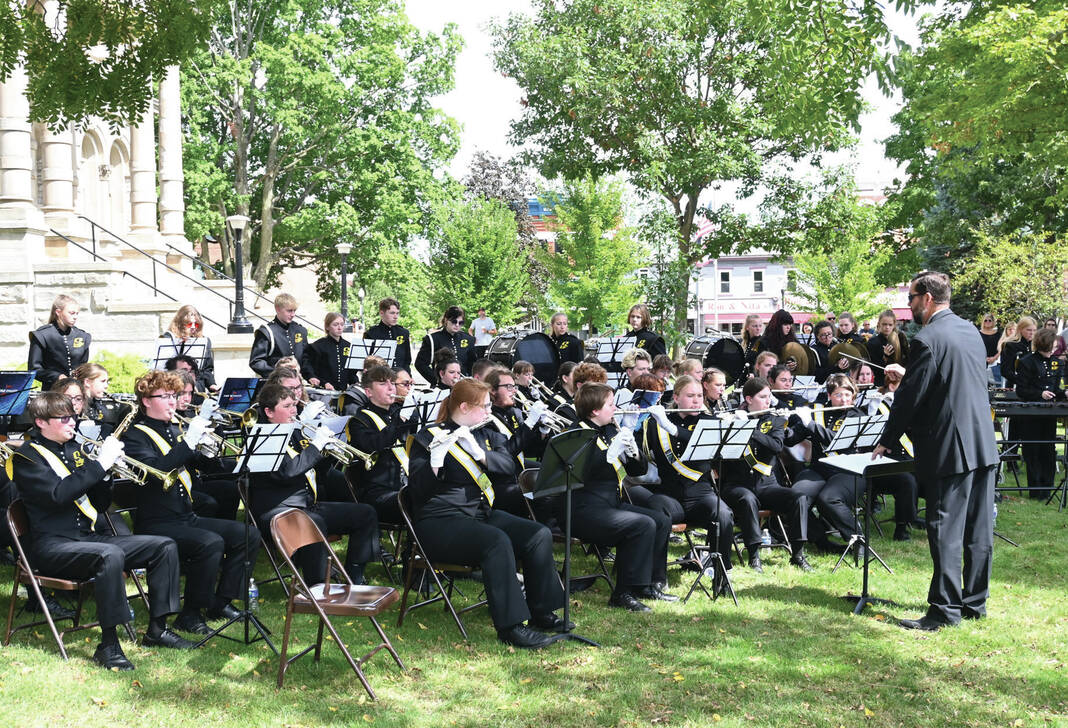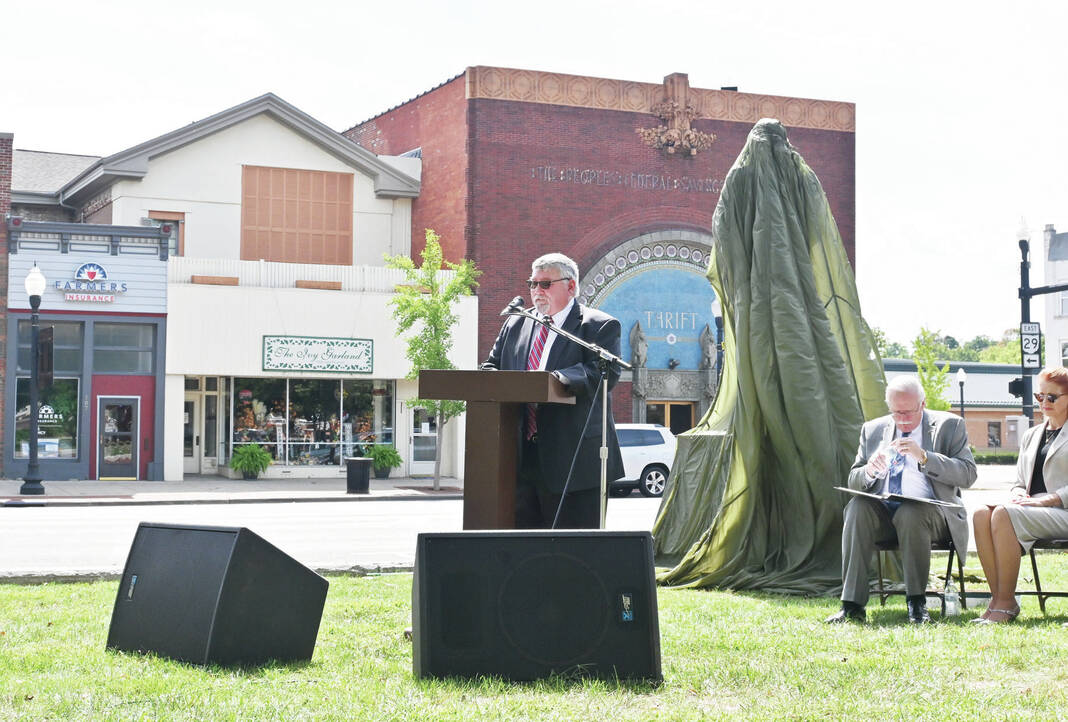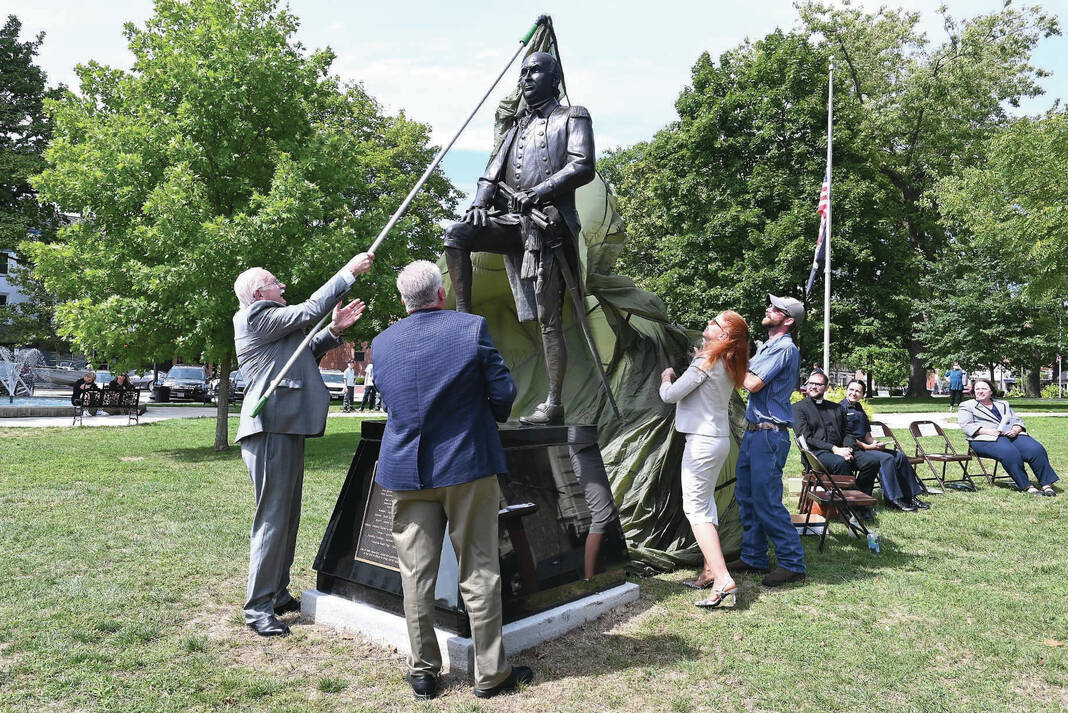


SIDNEY — Precisely at 2 p.m. Saturday afternoon, Sidney High School Band Director Chris Adams raised his baton to direct the band as the members began playing “America the Beautiful.” As the final notes faded, the Sidney Veterans Honor Guard marched smartly across the Courthouse lawn with the American flag waving in the slight breeze that made the bright, sunny day tolerable.
Shelby County-Sidney Bicentennial Committee Co-Chair Mike Barhorst then stepped to the microphone, thanked the band for “providing such a beautiful instrumentation” and then thanked the members of the honor guard before talking about the ceremony that had been planned for July 18, 2020. He noted COVID-19 had changed those original plans, forcing the postponement of the event.
Barhorst then introduced Shelby County Commissioner Julie Ehemann. Ehemann is currently serving as president of the Shelby County Commission. In addition to welcoming those in attendance, she also thanked Barhorst and her fellow Commissioner Bob Guillozet for their leadership of the Shelby County-Sidney Bicentennial Committee.
Barhorst next introduced the Rev. Aaron Hess, the parochial vicar of Holy Angels, Sidney; Sts. Peter and Paul, Newport; St. Michael, Fort Loramie; and Sacred Heart, McCartyville. Hess offered the invocation.
Sidney Police Officer Kiarra Ibarra sang “The Star-Spangled Banner.” Ibarra is a recent graduate of the Ohio State Highway Patrol Academy, where she finished first academically in her class and sang the National Anthem at the Academy’s graduation exercises.
Barhorst returned to the microphone and spoke about the early planning for Sidney’s Bicentennial, which he said began on June 13, 2017. He noted he had asked Guillozet to serve on the planning committee.
“After our first two meetings,” Barhorst said, “Bob came to me following the meeting and said, ‘You know, Shelby County’s Bicentennial will be the year before Sidney’s. Why don’t you and your committee just plan both?’”
“My response, at least as best I can recall, was pretty immediate,” Barhorst said. “’Bob’, I said, ‘why don’t you take anybody off our committee you’d like and plan your own celebration?’”
“Bob’s response was also pretty immediate,” Barhorst recalled. “’Well, the first person off your committee I’d take would be you!’”
Barhorst recalled as he traveled the state he’d visit communities that had already celebrated bicentennials, and looked at what they might have done as a permanent reminder of their celebration. He specifically mentioned Marietta, Ohio’s oldest municipality, and Cleveland as examples.
Marietta’s committee had erected a marble fountain. “During most of my visits there, it was never working,” Barhorst said.
Barhorst said Cleveland’s committee had lighted the nine bridges across the Cuyahoga River.
“They claimed that the bridges would remain lighted for the next hundred years. They spent millions of dollars, and after just two years, the lights on the individual bridges began to go out,” Barhorst said. “I’m not sure that any of the bridges remain lighted today.”
Barhorst explained how the committee decided on commissioning a statue of the county’s namesake, recalled visits that he and Guillozet had made to the sculptor’s studio in Zanesville, Ohio, and even how they were not sure that the project would be finished in time.
“It was finished and delivered on time,” Barhorst told the audience, “but of course, in the end it didn’t matter whether it was or not.” The statue has been in storage since.
Barhorst spoke about Shelby’s gifts as a military strategist, providing the strategy to win battles in Lord Dunmore’s War, the American Revolutionary War, and the War of 1812.
“Interestingly, he didn’t care about getting the credit, he just knew that the sooner they experienced victory, the sooner they could return home to their loved ones,” Barhorst said.
He spoke about Shelby’s interest in education.
“Shelby served as a trustee of Transylvania Seminary (now University), as the founding board chair of Centre College, and as the founder of the Kentucky Society for the Promotion of Useful Knowledge,” Barhorst told the audience.
Barhorst spoke about Shelby being elected to the Virginia House of Delegates.
“After the boundary between Virginia and North Carolina was finally surveyed, Shelby discovered that he was actually living in North Carolina,” Barhorst explained. “He was subsequently elected to the North Carolina House of Commons by his neighbors. When he moved to Kentucky and helped Kentucky gain statehood, he was unanimously elected the first governor of Kentucky, and after serving a term, retired to his farm.
“There he lived happily for a few years until people he had never met started to make their way to his home begging him to save them from the indigenous tribes, who were increasingly belligerent because of the theft of their lands,” Barhorst said. “Shelby was again elected governor, raised 10,000 troops and joined forces with General William Henry Harrison. He gave Harrison the strategy to win the Battle of the Thames, and then made his way back to Traveler’s Rest, his home in Kentucky.
“I’ve not been able to find the trail he took from Canada back home to Kentucky, but it had to be in this general area; interestingly, people lined the trail, waited for him to return and thanked him for his ‘saving’ them,” Barhorst said. “Out of gratitude, Congress presented him with a gold medal. The president attempted to thank him by naming him secretary of war, a position Shelby declined, and of course, William Henry Harrison became president.”
Barhorst concluded his remarks by noting some of Shelby’s other accomplishments, including his wife and 11 children.
“Like each of us, he was far from perfect, but at the time he lived, he was considered one of the most important figures of his day,” Barhorst said.
Shelby County Commissioner Bob Guillozet thanked the members of the Bicentennial Committee who had served alongside of him for more than the better part of six years. He recalled some of the trips he had made with Barhorst to the sculptor’s studio in Zanesville, and his delight that the statue was finally “finished.”
Shelby County Commissioner Tony Bornhorst was then summoned to the podium, and he spoke about his admiration for Shelby’s love of his family and of the land. He compared Shelby to many who live and work in Shelby County today, “people who understand the value of hard work, the importance of faith and family, and their dedication to their country.”
The three commissioners and Barhorst then set about the work of unveiling the statue. Before it was over, even Shelby County maintenance worker Dan Hamilton lent a hand in helping remove the shroud that covered the statue. When it was finally removed, the audience responded with applause.
The program concluded with the Rev. Carol Pierson, the pastor of First Presbyterian Church, offering the benediction, the Sidney High School Band playing United We Stand, and the Sidney Veterans Honor Guard retiring the colors.




